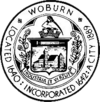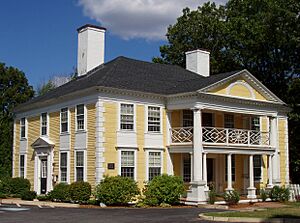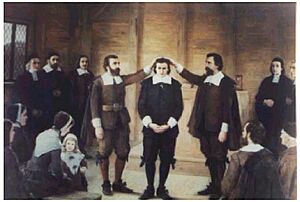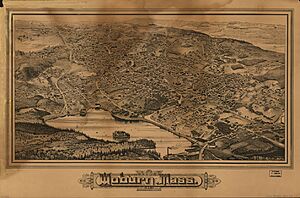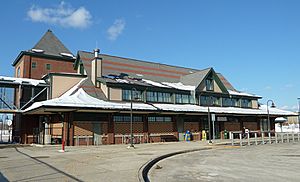Woburn, Massachusetts facts for kids
Quick facts for kids
Woburn, Massachusetts
|
||
|---|---|---|
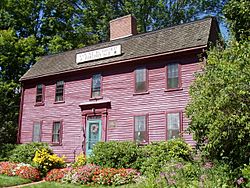
Benjamin Thompson House, Woburn, Massachusetts
|
||
|
||
| Motto(s):
Industria et Virtute (Latin)
"Industry and Virtue" |
||
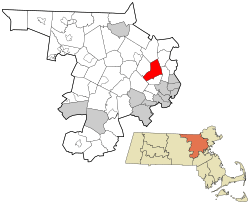
Location in Middlesex County, Massachusetts
|
||
| Country | ||
| State | ||
| County | Middlesex | |
| Region | New England | |
| Settled | 1640 | |
| Incorporated (town) | 1642 | |
| Incorporated (city) | 1889 | |
| Named for | Woburn, Bedfordshire | |
| Government | ||
| • Type | Mayor-council city | |
| Area | ||
| • Total | 12.94 sq mi (33.52 km2) | |
| • Land | 12.65 sq mi (32.76 km2) | |
| • Water | 0.29 sq mi (0.76 km2) | |
| Elevation | 100 ft (30 m) | |
| Population
(2020)
|
||
| • Total | 40,876 | |
| • Density | 3,231.30/sq mi (1,247.64/km2) | |
| Time zone | UTC−5 (Eastern) | |
| • Summer (DST) | UTC−4 (Eastern) | |
| ZIP Codes |
01801, 01888
|
|
| Area code(s) | 339/781 | |
| FIPS code | 25-81035 | |
| GNIS feature ID | 0612270 | |
| Website | www.woburnma.gov | |
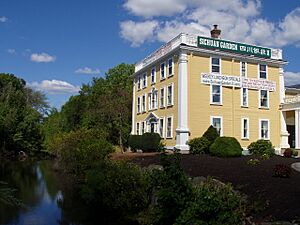
Woburn (pronounced WOO-bərn) is a city in Middlesex County, Massachusetts, United States. It's located about 9 miles north of Boston. In 2020, about 40,876 people lived there. Woburn is run by a mayor-council system. This means an elected mayor leads the city, and a city council makes laws. Some council members are chosen from different areas (wards), and others are chosen from the whole city.
Contents
History of Woburn
Woburn was first settled in 1640 near Horn Pond. This pond is a main source for the Mystic River. The area became an official town in 1642. Back then, Woburn was much larger. It included what are now the towns of Woburn, Winchester, Burlington, and parts of Stoneham and Wilmington.
How Woburn Got Its Name
Woburn was named after a town in England called Woburn, Bedfordshire. An important event happened here on November 22, 1642. It was the first time a religious minister was officially appointed in the Americas. Rev. Thomas Carter became the minister of Woburn. Many important people from New England were there. This included John Cotton and Richard Mather.
The "Father of Woburn"
Captain Edward Johnson helped start the church and town of Woburn. He is known as the "Father of Woburn." He was the first town clerk. He also represented the town in the Massachusetts General Court. He even made the first map of Massachusetts and wrote the first history of the colony.
Early Town Meetings
The first official Town Meeting in Woburn happened on April 13, 1644. During this meeting, the first town officers were chosen. These officers included the first selectmen and a constable. Deacon Edward Convers was also a founder of Woburn. He built the first house and the first mill in the town. He was very involved in town matters.
Important Moments in Woburn's History
- In 1803, the Middlesex Canal opened. This was an important waterway.
- The Boston and Lowell Railroad began running through Woburn in 1835.
- The first public library opened in 1879.
- The telephone came to Woburn in 1882. Electric lights arrived in 1885.
- Woburn officially became a city on June 12, 1888.
- Major roads like Route 128 (in 1951) and Route 93 (in 1963) were built.
- Cummings Properties, a big company that owns many buildings, was started in 1970.
- In 2011, Woburn was recognized as a "Bio-Ready community" for its support of biotechnology.
Water Contamination Incident
In the 1970s, people in Woburn became worried. Many children in the Pine Street area were getting sick with leukemia and other illnesses. In 1979, high levels of chemicals were found in the city's water wells. People thought the chemicals might be causing the health problems.
A lawsuit was filed in 1982 against two companies. These companies were thought to have polluted the groundwater. A book called A Civil Action was written about this case by Jonathan Harr. Later, a movie with the same name was made in 1998, starring John Travolta.
Geography and Climate
Woburn is located at 42°29′4″N 71°9′7″W / 42.48444°N 71.15194°W. It shares borders with several other towns. These include Wilmington, Reading, Stoneham, Winchester, Lexington, and Burlington.
The city has a total area of about 12.9 square miles (33.5 square kilometers). Most of this area is land, with a small part being water.
Woburn's Weather
Woburn has a humid continental climate. This means it has four distinct seasons.
- Winters are usually cold, but not as extreme as some other places. Sometimes, very cold air can cause temperatures to drop below zero.
- Spring starts cool, often with snow still on the ground. It quickly warms up as summer gets closer.
- Summers are generally warm or hot and can be humid. Temperatures often reach the 80s.
- Falls are usually crisp and cool. They start warm but quickly get colder, feeling more like winter by the end.
Population Information
| Historical population | ||
|---|---|---|
| Year | Pop. | ±% |
| 1790 | 1,727 | — |
| 1800 | 1,228 | −28.9% |
| 1810 | 1,219 | −0.7% |
| 1820 | 1,519 | +24.6% |
| 1830 | 1,977 | +30.2% |
| 1840 | 2,993 | +51.4% |
| 1850 | 3,956 | +32.2% |
| 1860 | 6,287 | +58.9% |
| 1870 | 8,560 | +36.2% |
| 1880 | 10,931 | +27.7% |
| 1890 | 13,499 | +23.5% |
| 1900 | 14,254 | +5.6% |
| 1910 | 15,308 | +7.4% |
| 1920 | 16,574 | +8.3% |
| 1930 | 19,434 | +17.3% |
| 1940 | 19,751 | +1.6% |
| 1950 | 20,492 | +3.8% |
| 1960 | 31,214 | +52.3% |
| 1970 | 37,406 | +19.8% |
| 1980 | 36,626 | −2.1% |
| 1990 | 35,943 | −1.9% |
| 2000 | 37,258 | +3.7% |
| 2010 | 38,120 | +2.3% |
| 2020 | 40,876 | +7.2% |
| 2023* | 41,647 | +1.9% |
| * = population estimate. Source: United States Census records and Population Estimates Program data. Source: U.S. Decennial Census |
||
In 2000, there were 37,258 people living in Woburn. The city had about 15,000 households. About 26.8% of these households had children under 18. The average household had 2.47 people.
The median age in the city was 38 years old. This means half the people were younger than 38 and half were older. For every 100 females, there were about 95.6 males.
Economy and Business
The Woburn Business Association (WBA) is a group for companies in Woburn. Its goal is to help and support businesses in the city. They also provide ways for business people to meet and work together.
The Woburn Redevelopment Authority (WRA) helps with community development. It works to improve the city's areas.
Many companies have their main offices in Woburn. These include Boston Acoustics, Boston Metal, Kaspersky Lab USA, Monotype, Skyworks Solutions, and U-Turn Audio.
Top Employers in Woburn
Here are some of the largest employers in Woburn:
| # | Employer | # of Employees |
|---|---|---|
| 1 | Marshalls | 1,000–4,999 |
| 2 | NECC | 500–999 |
| 3 | New England Rehabilitation Hospital | 500–999 |
| 4 | Chomerics | 500–999 |
| 5 | Aberjona Valley Distributors | 250–499 |
| 6 | Atlantic Boston Construction | 250–499 |
| 7 | Cummings Properties | 250–499 |
| 8 | The Dolben Company | 250–499 |
| 9 | Peterson Party Center | 250–499 |
| 10 | Sanmina | 250–499 |
| 11 | Skyworks Solutions | 250–499 |
| 12 | Target | 250–499 |
| 13 | United Stationers Supply Company | 250–499 |
| 13 | Xius | 250–499 |
Education in Woburn
Woburn has several public elementary schools. These include Goodyear, Altavesta, Shamrock, Malcolm White, Clyde Reeves, Linscott-Rumford, and Hurld-Wyman Elementary. There are two middle schools: John F. Kennedy Middle School and Daniel L. Joyce Middle School.
Recently, some schools like Goodyear, Reeves, Shamrock, Malcolm White, and Woburn Memorial High School have been rebuilt. Some older school buildings are now closed. For example, the former Veterans' Memorial School is now the Woburn Senior Center.
St. Charles is a private Catholic school for Pre-K through 8th grade. It has been graduating students since 1884.
Public Water Supply
Woburn is special because it provides most of its own drinking water. The city gets its water from five wells near the Horn Pond area. This water is then cleaned and treated at the Horn Pond Treatment Plant. About one-third of Woburn's water comes from the Massachusetts Water Resources Authority.
Transportation in Woburn
- The Anderson Regional Transportation Center is a major travel spot. You can catch Amtrak trains to Portland, Maine from here.
- The MBTA Commuter Rail also runs from this center to Boston's North Station and Lowell, Massachusetts.
- Buses from the center go to Logan International Airport and Manchester-Boston Regional Airport.
- The Mishawum station is another stop on the commuter rail.
- MBTA bus routes travel through Woburn on main roads. These buses connect Woburn to nearby towns like Burlington and Wilmington, and also to Boston.
Famous People from Woburn
Many notable people have come from Woburn:
- Col. Loammi Baldwin: A Revolutionary War engineer who helped build the Middlesex Canal.
- Eric Bogosian: An actor, playwright, and novelist.
- John Carter: A former player for the Boston Bruins hockey team.
- Edward Convers: One of the founders of Woburn.
- Charles Goodyear: The inventor of vulcanized rubber.
- Edward Johnson: Known as the "Father of Woburn."
- Courtney Kennedy: An Olympic medalist in women's ice hockey.
- David Robinson: A rock drummer.
- Benjamin Thompson: Also known as Count Rumford, a famous scientist and inventor.
- Philemon Wright: Considered the founder of the Canadian cities Ottawa, Ontario, and Gatineau, Quebec.
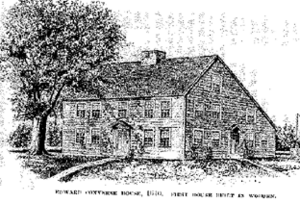
Places to Visit in Woburn
- 1790 House
- Baldwin House
- Benjamin Thompson House
- Winn Memorial Library
- Woburn Memorial High School
- US Post Office: A historic building with a Classical Revival style.
- First Congregational Church in Woburn: An 1860 church that belongs to a congregation started in 1642.
See also
 In Spanish: Woburn (Massachusetts) para niños
In Spanish: Woburn (Massachusetts) para niños


